I suspect the fact that I’m getting old (older?) is something I just have to deal with. Like when you have to insert your birth date within an online form using a drop-down menu for the years, and it takes forever to actually scroll all the way back to the dark ages (1956.) It’s all illustrated right before your eyes when you do that. But one of the joys of being my age is all the momentous stuff I lived through and still remember. I don’t know any of my passwords, but my brain retains specific details of events ranging from world-changing to mundane, as far back as when I was three years old. I will never forget July 20, 1969. This was a good week for those memories, and many others.
A bunch of us Wilbers, including cousins from Pennsylvania, were spending a few weeks at our rental cottage in Michigan. Wampler’s Lake (right outside of Brooklyn) was a summer magnet for us nearly every year. My sister Mary and I were automatic once we turned 10 or so, but my brother Del wasn’t there as much. By the time I started going to Wampler’s he was playing professional baseball during the summers, so it was rare to have him up there with us. By 1969, he was out of baseball and working in St. Louis for Procter & Gamble, so that’s why he and his wife Kay were along for the trip.
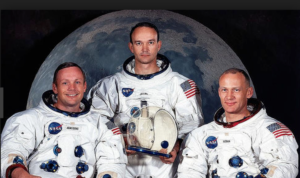
After our stay, I rode home to St. Louis with Del and Kay in their car. Moving the AM radio dial right and left, as we made the trip home from southern Michigan, we found radio stations that were providing “live” updates on the Apollo 11 mission. Finally, somewhere in Illinois I assume, we heard the unforgettable words “Houston, Tranquility Base here. The Eagle has landed.” I was in the back seat, transfixed.
We got home to their apartment near the St. Louis airport, and all climbed onto their bed in the master bedroom, with a TV perched on a stand at the foot of the bed. I remember thinking it was REALLY late at night, but it probably just seemed that way after the long drive and a fun vacation. I was 13 years old.
It feels like I remember every second of it. I clearly recall that when the fixed mounted TV camera was deployed and turned on, the picture was terrible. It was full of contrast and nothing on the screen looked like an astronaut or the moon. Then NASA discovered the image was upside down, and the picture was so bad due to the bright contrast of the lunar surface. Mission Control adjusted some settings and finally there was Neil Armstrong, coming down the ladder instead of the reverse. These moments are seared into my memory. We watched every minute of the two and a half hours Neil and Buzz Aldrin were on the moon, so by then it actually was pretty late for young Bobby Joe Wilber. It was after midnight.
Of course we all know the words Armstrong spoke when he stepped off the landing pad to put his boot on the moon. Or at least we think we know. He had come up with the statement and practiced it regularly. What he wrote was “That’s one small step for a man, one giant leap for mankind.” For some reason, he either forgot to make it “for a man” or the “a” just didn’t get transmitted. What we all heard was “That’s one small step for man, one giant leap for mankind” which doesn’t make nearly as much sense as the written version. NASA later went in and edited the official transcript by adding the “a” to the statement.
All of the memorials, documentaries, and special shows about Apollo 11, these last few weeks, brought back tons of other memories. I was a certified space program geek from the earliest days. I rarely could focus on anything other than baseball (I’m sure I had A.D.D. back then but no one knew it) but when it came to the space program I had a laser-like focus for all the details.
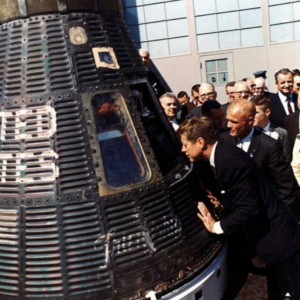
I remember Project Mercury like it was yesterday, despite the fact I wasn’t yet five years old when it kicked off and Alan Shepard became the first American in space. His little rocket didn’t have enough oomph to put him into orbit, but he went up there and came back in that tiny little capsule. I heard, later in life, some of the Project Mercury astronauts say things like “You didn’t really get into the Mercury capsule, as much as you sort of put it on.” In addition, NASA originally didn’t have plans to put a window on the Mercury capsule. The astronauts were just seen as passengers. These former test pilots refused to do that. They insisted on a window and on operating systems during the flights.
Many people still think John Glenn was the first American in space, but he was second. He was the first American to orbit the Earth.
Scott Carpenter, Gus Grissom, Gordon Cooper, Wally Schirra, John Glenn, Alan Shepard, and Deke Slayton. That first group of seven Mercury astronauts were true American heroes. Getting into space was an easy concept, in theory. But someone had to strap into that thing and make it happen in reality. These guys are the reason the book and the movie “The Right Stuff” were written and made. Absolute heroes, and like movie stars to me.
Project Mercury was all about getting men up there and seeing what happened. And then getting them back down without burning them up. The USA and Soviet Union had sent animals into space, and they came back OK, so it was time to send men up there. Could you eat in space? Could you relieve yourself? Would you lose your mind in that tiny capsule? No one really knew until those guys went up.
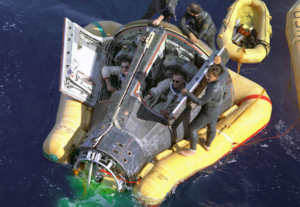
Later in the 60s, Project Gemini took over with two-man capsules and much longer missions. Gemini was the practice field for just about everything we’d need to do in order to get men to the Moon. Long flights, docking and undocking, maneuvering the space craft. I had a front row seat for much of it.
One of my best friends, at the time, was Scott Youngstrom. We had met at day camp, and could ride our bikes to each other’s homes. Scott’s dad worked for McDonnell Aircraft (soon to merge with Douglas Aircraft to become McDonnell Douglas) which had its headquarters in St. Louis and was a major NASA contractor, and he worked on the Gemini program for the company. We got to see all sorts of cool renderings and even some material that came back to Earth on the flights. I don’t know how many St. Louisans worked at McDonnell back then, but it was a lot. It was a badge of pride for the city to have so many locals working in conjunction with NASA.
Also, at the time, my mother was working for KMOX Radio in St. Louis, one of the most powerful and respected A.M. stations in the country, with a signal that could nearly blanket the USA on a clear night. She normally did entertainment interviews, or other “light fluff” like that, but with the space program gaining so much traction during the “space race” against the Soviets, she often had assignments out at McDonnell, at its massive campus just across the main runways from Lambert Airport. I was lucky enough to go on a few of those assignments and see some really cool stuff.
With St. Louis being such a big part of the entire space program, NASA always seemed to be sending used capsules and other space stuff to town, usually displaying it all at the St. Louis Planetarium in Forest Park. Seeing those singed and burned heat shields brought to life what the TV analysts were talking about when they discussed the dangers of reentry. And even the Gemini capsule seemed absolutely tiny to me. How could two big strong men spend eight or nine days in there?
When the Apollo program began, the race was on for the Moon. And then we lost three courageous men in a horrifying fire inside the capsule during a test on the pad in Florida. Gus Grissom (yes, one of those original Mercury heroes), Ed White (the first American to walk in space), and Roger Chaffee were incinerated within seconds. It was a huge blow to the program, to the country, and to St. Louis. It was a tragedy, but NASA learned from it and nothing like it ever happened again.
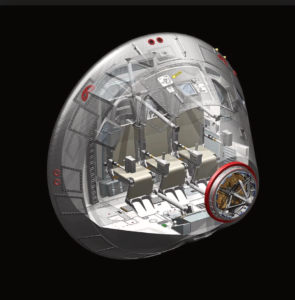
Finally, nearly two years after the fire, Apollo 7 took three men into Earth orbit. It was a daring test of will to launch that rocket into space. The crew and everyone at NASA had lost dear friends in the fire. It was a successful flight, and it readied NASA to head for the moon. It readied me for a number of consecutive years when Apollo flights were the absolute highlight for me. I couldn’t “geek it up” enough.
Apollo 8 went to the moon, circled it, and came back. It was our first chance to see what the Earth looked like from that far away, and to see “Earthrise” over the Moon’s horizon. The TV was gripping, to see the “big blue marble” floating in space, with all of us on it.
I don’t know why, and it may not be true, but it always seems to me that these missions took place late at night, and it was one time when my mom and dad never had a problem with me staying up as late as I wanted to watch it all. Another such time was when my mom was working for the Cardinals and they’d be coming back to Lambert Airport in the middle of the night after winning a World Series or clinching a pennant. No questions asked. I got to go with her and try to stay up until the plane landed around 3:00 in the morning.
Apollo 9 just orbited the Earth, but it gave the crew the first chance to undock and extract the Lunar Excursion Module (otherwise known as the LEM or Lunar Module) so it was critical for the program.
Apollo 10 went to the moon and did a planned practice for landing, undocking the LEM but not landing it.
Apollo 11 made history. And I made history for “longest time spent in bed with Del and Kay at their apartment.”
Apollo 12 is memorable for me for one lousy reason. When they landed and descended the ladder to the surface, they set up the color TV camera on its tripod but something went haywire when it was inadvertently pointed at the sun. The camera never worked, and I was heartbroken. Apollo 12 was otherwise a brilliant success, and it even purposefully landed within walking distance of the Surveyor 3 Moon probe NASA had landed on the surface in 1967. The first time men from Earth had touched something on the moon that other humans had put there.
We know about Apollo 13. I was as riveted as everyone, as NASA and the crew struggled mightily to keep the three men alive and get them back home after an explosion vented nearly all their oxygen into space. When they did come back, I had to watch on TV from home. I was sick and not in school that day. My friends later told me how many of them were crying as they waited to see if the giant parachutes would ever blossom over the ocean.
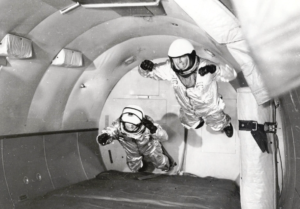
And of course, the Ron Howard movie “Apollo 13” brought it all into gripping reality. Did you know that those scenes of Tom Hanks, Kevin Bacon, and Bill Paxton floating around weightless inside Apollo 13 were NOT special effects? They were very real, and done on a specialized airplane that flies enormous parabolic “up and down” loops to create weightlessness at the top of the parabola. If you’ve ever ridden a really fast elevator in a skyscraper, you know the feeling of rising up on your toes when it slows and stops at the top. The same concept works on the plane, but you don’t just rise up on your toes. They built an Apollo 13 set on the aircraft to shoot those scenes up there. That’s how astronauts get trained, but by all accounts it’s not a pleasant experience. That’s why they call it the Vomit Comet.
Apollo missions 14 through 17 went off without major hitches, and included such fun stuff as the Lunar Rover, a car they could drive around to get much further away from the LEM. But, the public was losing interest. I wasn’t, I watched every minute of TV provided to me, but by Apollo 17 it was time to wrap it up. I was crushed.
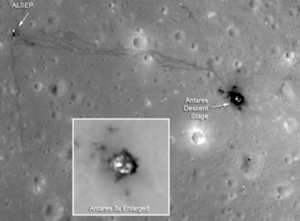
And here’s another “Did You Know?” factoid. Over the years the US and other countries have sent reconnaissance satellites to the moon, making low-level passes and taking photos. If you dig enough on the interwebs, you can see they’ve documented all of the Apollo landing sites. With no wind or atmosphere on the Moon, you can still see equipment and tests on the ground, as well as the LEM descent and landing stages, and tire tracks made by the Rovers. It’s absolutely fascinating to see those images. I believe there are still laser mirrors left on the Sea of Tranquility by Apollo 11, and NASA can still bounce beams off them to get an exact reading for how far the Moon is from Earth, at any given time. Here’s hoping that number never surprises them!
So July 20 was a full-on memory trigger for me. I’m not so happy about being 63 for a lot of reasons, but I’m thrilled it means I remember all of this amazing stuff. I lived through it. It had a huge impact on me, and still does. And it was all dreamt up, created, and performed by men who had “The Right Stuff” in spades. It was a fabulous time to be a space geek.
I hope we go back someday. If we’re serious about putting humans on Mars we’re going to need the Moon as part of that program.
So that’s it for this “space geek” week.
As always, if you enjoyed this trip through NASA history please hit the “Like” button at the top. Maybe that will earn me some sort of space geek merit badge for my “Members Only” jacket!
See you in a week.
Bob Wilber, at your service and about to blast off…